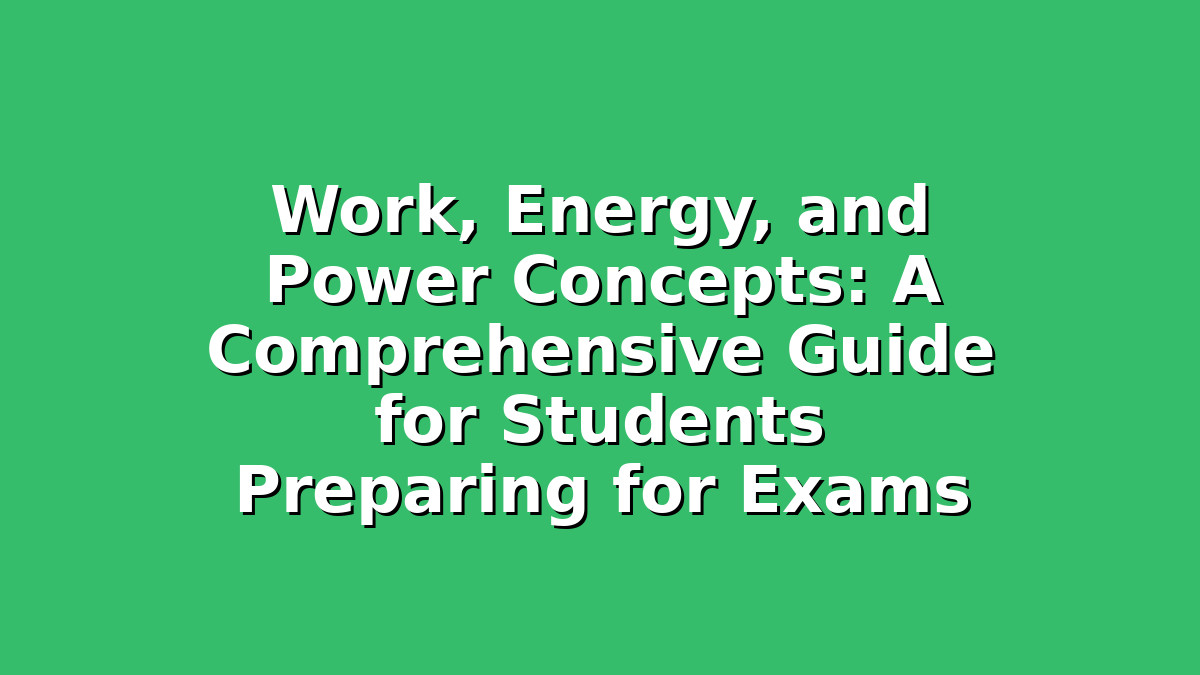When preparing for exams in physics, understanding the concepts of work, energy, and power is essential. These fundamental ideas form the backbone of many problems and theories you’ll encounter, not just in school tests but also in practical applications. Whether you’re struggling to grasp the formulas or looking for effective study strategies to master these topics, this guide is designed to help you build confidence and improve your understanding. In this article, we’ll break down key concepts, provide study tips, and offer advice to help you excel in your exams.
Understanding Work: The Foundation of Energy Transfer
Work is one of the first concepts you’ll meet when studying mechanics. Simply put, work is done when a force causes an object to move in the direction of that force. The formula for work is:
Work (W) = Force (F) × Displacement (d) × cos(θ)
where θ is the angle between the force and the direction of displacement.
Study Tip #1: Visualize the Concept
To truly understand work, try to visualize situations where work is being done and where it’s not. For example, pushing a box across a floor involves work, but holding a heavy box stationary does not, since there is no displacement. Drawing diagrams and labeling forces and displacements can be incredibly helpful.
Study Tip #2: Master the Units and Signs
Work is measured in joules (J), and it’s important to remember the sign of the work done. If the force and displacement are in the same direction, work is positive. If they are in opposite directions, work is negative. This sign convention is vital when solving problems involving friction or other opposing forces.
Study Tip #3: Practice Word Problems
Many exam questions present work-related problems in a story format. Practicing these helps you identify what information is given and what you need to find. Create your own practice problems by thinking of real-life situations where forces move objects, and calculate the work done.
—
Exploring Energy: Different Forms and Conservation
Energy is the capacity to do work, and it exists in various forms — kinetic, potential, thermal, chemical, and more. In the context of exam physics, kinetic energy (energy of motion) and potential energy (stored energy) are most commonly tested.
Kinetic Energy (KE) = ½ mv²
where m is mass and v is velocity.
Potential Energy (PE) = mgh
where m is mass, g is acceleration due to gravity, and h is height.
Study Tip #1: Understand Energy Conversion
A classic example involves a pendulum or a roller coaster, where energy continuously converts between kinetic and potential forms. Visualize these conversions to grasp the concept better. For instance, at the highest point, potential energy is maximum and kinetic energy is minimum. At the lowest point, kinetic energy peaks while potential energy drops.
Study Tip #2: Use Energy Conservation Principles
The Law of Conservation of Energy states that energy cannot be created or destroyed, only transformed. This principle is the key to solving many exam problems. Practice creating energy conservation equations and solving for unknowns like velocity or height.
Study Tip #3: Create Summary Sheets
Make a summarized sheet that lists different types of energy, their formulas, and units. Include common examples and typical problems you’ve solved. Reviewing this sheet regularly can boost your retention and recall during exams.
—
Power: Rate of Doing Work
Power measures how quickly work is done or energy is transferred. It is defined as:
Power (P) = Work done (W) / Time taken (t)
The unit of power is the watt (W), where 1 watt equals 1 joule per second.
Study Tip #1: Relate Power to Real-Life Examples
Understanding power becomes easier when you relate it to everyday situations such as the difference between a fast runner and a slow one, or a heavy machine working quickly. Visual examples like these make abstract concepts tangible.
Study Tip #2: Practice Unit Conversions
Power is sometimes expressed in kilowatts (kW) or horsepower (hp). Make sure you’re comfortable converting between these and watts. Familiarize yourself with quick calculation methods to avoid losing time during exams.
Study Tip #3: Solve Timed Problems
Since power involves time, practice solving problems where you calculate how long a job takes given the power, or how much power is needed to do a task in a certain time. Timing yourself will help you manage your exam time effectively.
—
Conclusion
Work, energy, and power are interconnected concepts that form the cornerstone of many physics questions. To succeed in exams, focus on understanding the fundamentals through visualization, consistent practice, and relating topics to real-life examples. Use summary sheets and practice word problems to reinforce your knowledge. Remember, steady effort and smart study strategies will help you master these essential physics topics with confidence. Keep practicing, stay curious, and approach each problem step-by-step—you’ve got this!

Responses